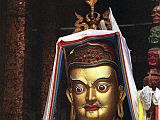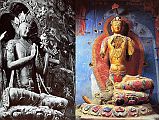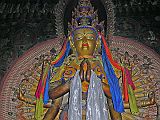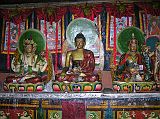




03-1 Avalokiteshvara Four Arms [4 of 15]
Avalokiteshvara, pronounced Ah-va-low-key-tesh-va-ra, (Tib. Chenrezig) is the patron saint of Tibet and his mantra, Om Mani Padme Hum, is carved on stones and chanted repeatedly. He has many forms, the most common one having one face, four arms, and two legs crossed in the meditation posture. His two front hands are pressed together at the heart, holding the wish-fulfilling jewel. The jewel signifies infinite bodhichitta, the intense desire to bring all suffering beings to enlightenment. Of his back two hands, the right one holds the crystal rosary, symbolizing liberation from samsara, while the left holds a blue utpala flower, symbol of his compassion.




